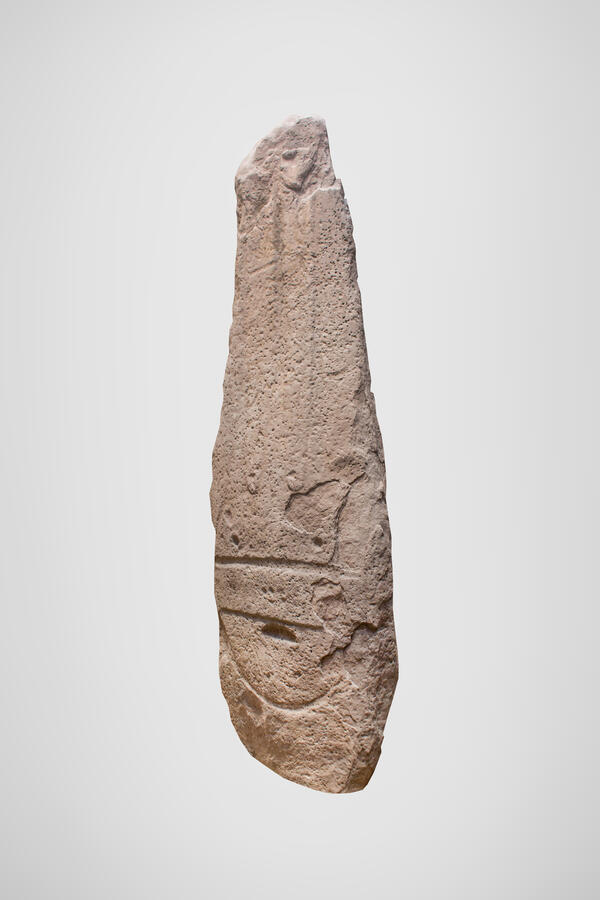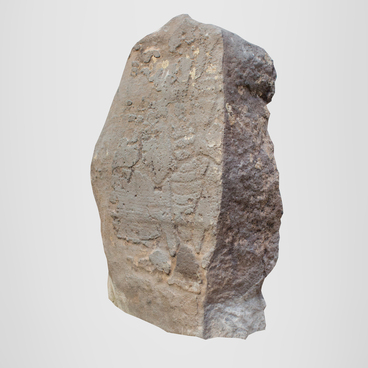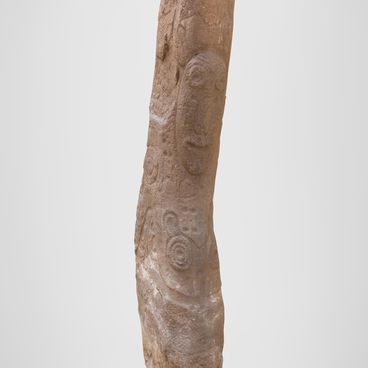Initially, this statue, found in the Askiz district of the Republic of Khakassia, was used as a menhir in the fence of the Tagar mound near the ulus (settlement) Terenty —Teren chin aal.
Menhir is a roughly cut stone block vertically installed by a man. They were installed both singly and in groups: in oval and rectangular “fences”, in semi-ovals, in lines, possibly many kilometers long ones, and in alleys. Menhirs reached a height of 4-5 meters and more. The largest of the found menhirs is 20 meters high and weighs almost 300 tons. There are no drawings on the simplest and most ancient monuments, however, over time, carved ornaments, bas-reliefs, as well as images of objects that archaeologists conditionally call stone axes, plows, shepherd’s staffs and yokes began to appear on the menhirs. The fragments of the menhirs were used to build burial chambers, while they were covered with new drawings over the old ones.
The presented menhir is made of a massive block of red sandstone. It is dated from the Okunev archaeological culture. The face of the deity depicted on it is divided by two horizontal lines into three parts. At the top, in the form of two circles and dots in them, the eyes and pupils are depicted. The nose is marked in the middle. The mouth of the mask is engraved in the lower part. Three beams go up. Over time, some of the stone peeled off and the drawing was damaged.
Archaeologists have discovered a number of similar masks with three spear-shaped points above their heads. Presumably, these drawings convey the appearance of the God of Thunder or Thunderstorm. They are known in the beliefs of many ancient peoples and cultures. For example, in the “Rig Veda” — a collection of religious hymns, the first known monument of Indian literature in the Vedic language — the thunderer Indra, the god of light and the strangler of the dragon Shushna, the sower of drought, is mentioned. According to legend, he was armed with a thunderbolt (vajara), which was originally a phallus of a bull.
In the sacred hymns of the “Rig Veda”, Maruta — the deities of storm, thunder and lightning — were celebrated as beautiful warriors who sparkle with spears. Spears or swords were part of the equipment and costume of shamans of most Siberian peoples. They were used during rituals depicting the struggle of the shaman’s spirits with hostile spirits. Humanoid spirits with three points on their heads or with a blade were depicted on many shamanic items both in antiquity and in the Middle Ages.
Menhir is a roughly cut stone block vertically installed by a man. They were installed both singly and in groups: in oval and rectangular “fences”, in semi-ovals, in lines, possibly many kilometers long ones, and in alleys. Menhirs reached a height of 4-5 meters and more. The largest of the found menhirs is 20 meters high and weighs almost 300 tons. There are no drawings on the simplest and most ancient monuments, however, over time, carved ornaments, bas-reliefs, as well as images of objects that archaeologists conditionally call stone axes, plows, shepherd’s staffs and yokes began to appear on the menhirs. The fragments of the menhirs were used to build burial chambers, while they were covered with new drawings over the old ones.
The presented menhir is made of a massive block of red sandstone. It is dated from the Okunev archaeological culture. The face of the deity depicted on it is divided by two horizontal lines into three parts. At the top, in the form of two circles and dots in them, the eyes and pupils are depicted. The nose is marked in the middle. The mouth of the mask is engraved in the lower part. Three beams go up. Over time, some of the stone peeled off and the drawing was damaged.
Archaeologists have discovered a number of similar masks with three spear-shaped points above their heads. Presumably, these drawings convey the appearance of the God of Thunder or Thunderstorm. They are known in the beliefs of many ancient peoples and cultures. For example, in the “Rig Veda” — a collection of religious hymns, the first known monument of Indian literature in the Vedic language — the thunderer Indra, the god of light and the strangler of the dragon Shushna, the sower of drought, is mentioned. According to legend, he was armed with a thunderbolt (vajara), which was originally a phallus of a bull.
In the sacred hymns of the “Rig Veda”, Maruta — the deities of storm, thunder and lightning — were celebrated as beautiful warriors who sparkle with spears. Spears or swords were part of the equipment and costume of shamans of most Siberian peoples. They were used during rituals depicting the struggle of the shaman’s spirits with hostile spirits. Humanoid spirits with three points on their heads or with a blade were depicted on many shamanic items both in antiquity and in the Middle Ages.



